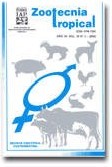
|
Zootecnia Tropical
Instituto Nacional de Investigaciones Agrícolas Venezuela
ISSN: 0798-7269
Vol. 25, No. 2, 2007, pp. 129-134
|
 Bioline Code: zt07016
Bioline Code: zt07016
Full paper language: Spanish
Document type: Research Article
Document available free of charge
|
|
|
Zootecnia Tropical, Vol. 25, No. 2, 2007, pp. 129-134
| en |
Comparative study of three vaccine strains of the virus that affect the bursa in broilers
Saume, Elsy; Sogbe, Elio; Castro, Marïa J. & Ascanio, Marisela
Abstract
The virus that infects the bursa In broilers (IBDV) causes one of the most important immunosuppressive diseases in commercial poultry. The present study was designed to compare the effect on the broiler’s bursas of three vaccines made with three different viral strains, mild, intermediate and intermediate plus, of IBDV. It was evaluated by means of comparing the bursa/body weight ratios and bursa histopathological changes. The experiment was conducted with 200 cobb x cobb broiler chickens, divided in 4 groups of 50 chickens each. Each group consisted of 5 replicates of 10 chickens each. The groups were: (A) no vaccinated (control); (B) vaccinated with the mild strain, (C) vaccinated with the intermediate strain, and (D) the vaccinated with the intermediate plus.strain. The chicks received a first vaccination at ten days old. Chicks were slaughtered at 8, 16, 22, and 32 days post vaccination (PV), and body and bursal weights were recorded and bursa tissues were examined for histopathological changes. At 32 days PV only the intermediate plus vaccine produced atrophy of the bursa and significant histopahological differences (P<0.05) with the other groups. For the D, there were observed larger microscopic lesions and low reactivity at 8 and 32 d PV. These results suggest that the intermediate plus IBDV vaccine is more invasive as evidenced by smaller bursas and larger microscopic lesions.
Keywords
bursa infection, vaccinal strains, bursa.
|
| |
| es |
Estudio comparativo de tres cepas vacunales del virus causante de la enfermedad de la bursa en pollos de engorde
Saume, Elsy; Sogbe, Elio; Castro, Marïa J. & Ascanio, Marisela
Resumen
El virus de la enfermedad infecciosa de la bursa (EIB) produce una de las más importantes enfermedades inmunodepresivas del sector avïcola comercial. El presente estudio fue diseñ ado con el propósito de comparar el efecto producido sobre la bursa en pollos vacunados con las cepas suave, intermedia e intermedia plus de la EIB a través de la relación peso bursa/peso corporal y de diferentes cambios histopatológicos. Se realizó un ensayo con 200 pollos broiler del hibrido cobb x cobb, divididos en 4 grupos de 50 pollos, cada grupo se formó con 5 réplicas de 10 pollos. Los tratamientos consistieron en cuatro grupos: control (A), vacunados con la cepa suave (B), con cepa intermedia (C) y con cepa intermedia plus (D). Los pollitos fueron vacunados a los 10 dïas de edad y sacrificados a los 8, 16, 22 y 32 dïas post vacunación (PV) registrándose el peso corporal, y de la bursa, asï como los cambios histopatológicos en la bursa. A los 32 dïas PV sólo el grupo vacunado con la cepa intermedia plus presento atrofia bursal y diferencias (P<0,05) histopatológicas con los otros grupos, En el grupo, se observaron lesiones microscópicas mayores, y una menor reactividad a los 8 y 32 dïas PV. Estos resultados sugieren que la cepa intermedia plus de la EIB es más invasiva, evidenciándose a través de bursas más pequeñ as con mayores lesiones microscópicas.
Palabras-clave
enfermedad infecciosa de la bursa, cepas vacunales, bursa.
|
| |
© Copyright 2007 - Zootecnia Tropical
Alternative site location: http://www.sian.inia.gob.ve/repositorio/revistas_ci/ZootecniaTropical/ztindice.htm
|
|
